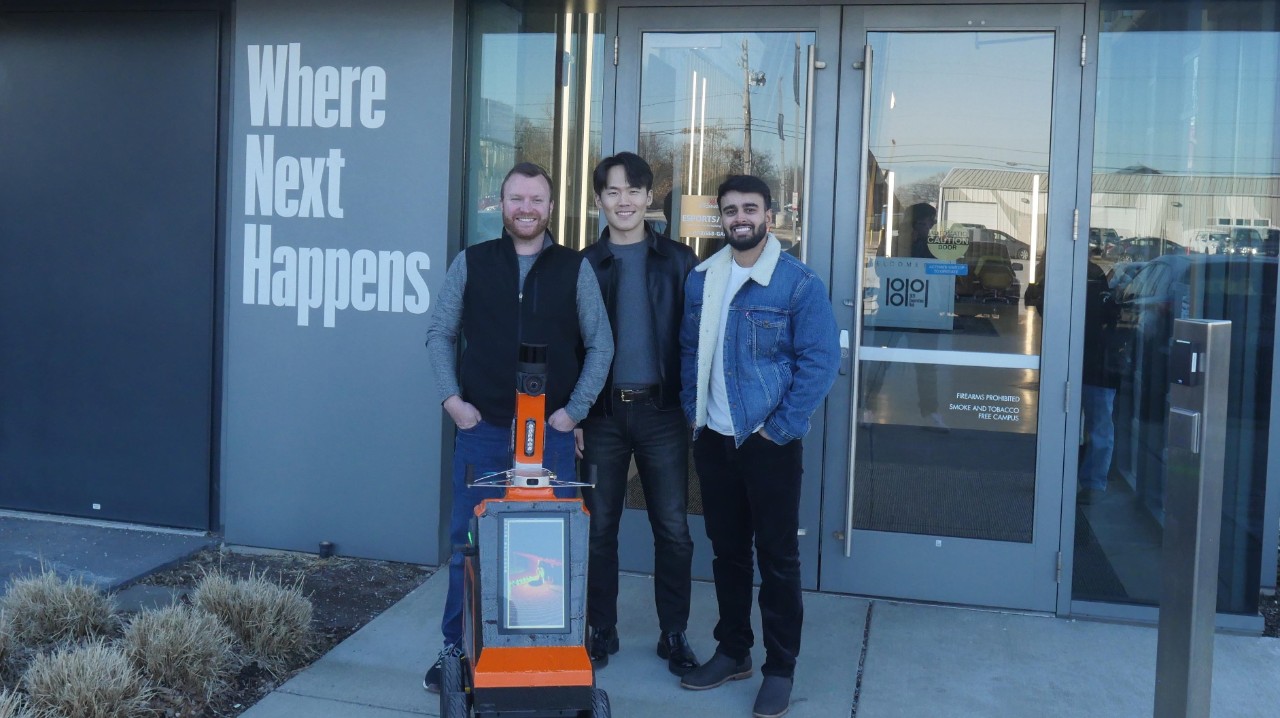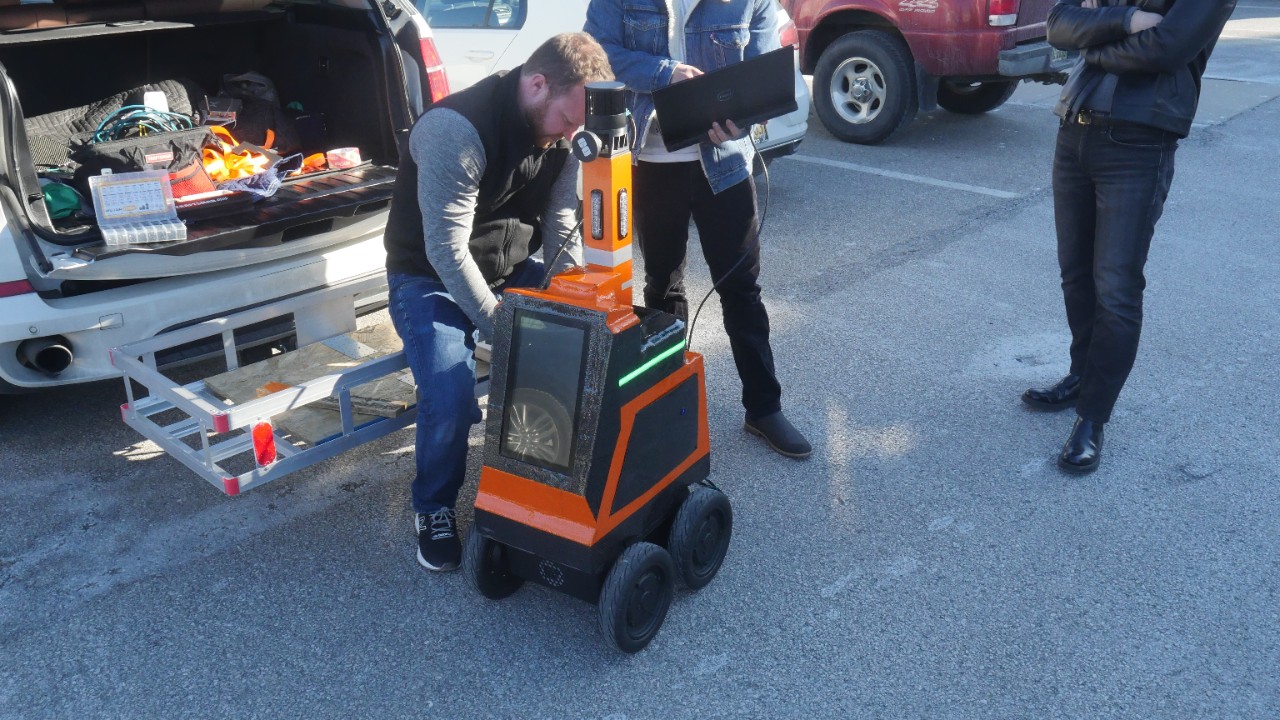
Groundbreaking UC startup propels aviation safety to new heights
Innovative robot poised to save billions in aircraft maintenance
Commercial aviation is a high-stakes, multi-billion-dollar industry where punctuality is paramount and cost efficiency is king.
Airlines face the daunting task of balancing on-time performance, operational costs and regulatory compliance, all while prioritizing the safety of passengers and meeting the stringent standards set by aviation authorities.
While aviation incidents such as crashes frequently make headlines, an article in the Wall Street Journal spotlighted the risks and safety hazards faced by the workforce beneath aircraft on the tarmac, which typically remains undisclosed to the public.
Local innovators Chris Kyoochul Lee, Jon Taylor and Huzefa Dossaji, offer a promising new startup solution to revolutionize aircraft ground handling process for enhanced safety.
They co-founded Airtrek Robotics, creating an autonomous robot that oversees ground crew tasks such as aircraft marshaling and foreign object debris (FOD) management. The technology operates within the aircraft safety envelope, ensuring no person or object is within the restricted perimeter during aircraft maneuvers.
“Airtrek Robotics aims to modernize outdated aircraft ground handling processes using autonomous technologies. This innovation utilizes advanced sensors and artificial intelligence to deliver an accurate, automated and cost-effective solution to enhance safety and efficiency of the operations,” Lee said.

Airtrek co-founder Jon Taylor works on the robot outside the 1819 Innovation Hub. Photo/Greg Glevicky
Prioritizing safety
Travelers often overlook the potential hazards of seemingly harmless objects on airport tarmacs, such as tools, luggage fragments, wildlife and debris. These items pose severe risks to aircraft, including tire damage, airframe punctures and engine issues. Moreover, when propelled by jet blast or rotor wash, FOD can cause injuries or fatalities among airport personnel.
The Federal Aviation Administration (FAA) estimates that damage from FOD costs the U.S. aviation industry $5.1 billion annually in lost revenue, with global costs reaching $13.9 billion annually.
Given the risky environment around aircraft, with engines running and constant motion, ground crews must always maintain acute situational awareness. Even the slightest oversight can lead to catastrophic consequences, resulting in severe injuries or loss of life. Aircraft marshalling, a crucial aspect of the ground handling process involving typically three personnel, is particularly susceptible to risks.
Last year, the FAA reported incidents in the marshalling area, including a fatal accident. This prompted a safety alert for operators, stressing the need for increased awareness and strict adherence to safety protocols during aircraft marshalling.
The technology of the Airtrek robot intends to play a pivotal role in marshalling procedures. Equipped with multiple sensors, these robots will serve as additional "eyes on the ground," augmenting and replacing the air marshalling process in some instances, further ensuring safety standards are met and exceeded.
With access to corporate partner support, the Venture Lab startup accelerator program and a state-of-the-art Groundfloor Makerspace, Airtrek illustrates how the 1819 Innovation Hub is the foundation for groundbreaking innovation.
Ryan Hays UC executive vice president and chief innovation and strategy officer
Standing out

The Airtrek robot in front of the UC 1819 Innovation Hub. Photo/Greg Glevicky
They’ve secured multiple grants, including one from Main Street Ventures, a Cincinnati-based nonprofit and partner of the 1819 Innovation Hub. This grant, known as the Entrepreneurial Launch Funding grant, was instrumental in supporting Airtrek's strategic co-founders. They utilized this capital along with coaching and resources provided by the Venture Lab pre-accelerator program, which specializes in accelerating startups from their inception to full commercialization.
As active startup partners within the 1819 ecosystem, Airtrek plans to capitalize further on its resources, enhancing the development of its robotic product by leveraging the facilities and support available at the UC Groundfloor Makerspace.
“Airtrek transformed their vision into reality," said Ryan Hays, UC executive vice president and chief innovation and strategy officer. "With access to corporate partner support, the Venture Lab startup accelerator program and a state-of-the-art Groundfloor Makerspace, Airtrek illustrates how the 1819 Innovation Hub is the foundation for groundbreaking innovation. This is the power of collaboration, driving startups to thrive and communities to prosper."
Cincinnati/Northern Kentucky International Airport (CVG) recognizes the potential in Airtrek's automated robotic capabilities as they begin their collaborative research and development stage toward product commercialization.
UC News previously toured CVG, where Chief Innovation Officer Brian Cobb commented how CVG is an ideal incubator for entrepreneurial innovators who wish to test an idea.
“Collaboration with a forward-thinking airport like CVG is a huge opportunity for us. Combining with CVG’s strategic guidance, we aim to transform the way the ground handling process happens, enhancing safety standards and productivity in the airfield,” Lee said.
Flying into the future but grounded in the past

AIrtrek robot at UC 1819 Innovation Hub. Photo/Greg Glevicky
The majority of aircraft ground handling remains manual and outdated. Without humans, airplanes are unable to dock at the gate. The prevalent method to mitigate FOD risks is still “FOD walks” where ground personnel manually inspect the ground and remove debris. Last year, an article on AviationPros cited a sluggish evolution of these procedures since the 20th century in the 1960s compared to the advancements in aircraft and airports.
“Autonomous technology is essential for modernizing the ground handling process. Autonomous robots can support human staff with laborious, monotonous and hazardous tasks. This collaboration allows human workers to redirect their efforts towards more complex, value-added activities in a safer environment, leading to heightened overall productivity,” Lee said.
The founders of Airtrek Robotics embody an innovative spirit and believe their technology can propel advancements in airport ground handling, revolutionizing the landscape of commercial aviation.
Featured image at top: Airtrek co-founders with their autonomous robot. Photo/Greg Glevicky
Impact Lives Here
The University of Cincinnati is leading public urban universities into a new era of innovation and impact. Our faculty, staff and students are saving lives, changing outcomes and bending the future in our city's direction. Next Lives Here.
Related Stories
We love ‘Lucy’ — the AI avatar redefining UC tech transfer
July 17, 2024
In a visionary leap at the University of Cincinnati, the marriage of artificial intelligence and interactive technology has birthed "Lucy," a Smarthelp AI avatar poised to revolutionize how regional industries engage with UC's tech transfer initiatives.
NIS program opens new horizons for international student
July 17, 2024
In his pursuit of physics and a taste for research, Akash Khanikor ventured from his hometown in India's Assam to the University of Cincinnati, drawn by the promise of hands-on exploration early in his undergraduate career as a NEXT Innovation Scholar.
Camp aims to empower children, teens who stutter
July 17, 2024
A one-week, evidence-based program for children and teens who stutter at the University of Cincinnati will teach kids to communicate effectively, advocate for themselves and develop confidence about their communication abilities. Camp Dream. Speak. Live., which is coming to Cincinnati for the first time July 22-26, began in 2014 at the University of Texas at Austin. The Arthur M. Blank Center for Stuttering Education and Research at UT expects to serve more than 2,000 children at camps across the United States, Africa, Asia and Europe this year.
UC Blue Ash takes next step in major renovation project
July 17, 2024
Muntz Hall, the flagship building on the University of Cincinnati Blue Ash College campus, is in the next phase of a major renovation project that will dramatically transform the main entrance, enhance access to student support services and add new spaces for students to study or meet between classes.
Presidential challenge to UC: Join Ride Cincinnati to fight cancer
July 16, 2024
UC President Neville Pinto has again challenged every UC college and unit to send at least one rider to the September 14 Ride Cincinnati event to help fundraise for cancer research and cancer care. UC students ride free. Signup by July 31 for free UC-branded cycling jersey.
Immersed in learning
July 15, 2024
The UC College of Nursing is transforming curriculum into immersive virtual reality experiences, providing students with more engaging, hands-on, and equitable learning.
Former UC rowing coach champions mentorship over medals philosophy
July 12, 2024
Two-time University of Cincinnati graduate Brent Figg has coached rowing teams for decades — now, he’s bringing his innovative mentorship style into transdisciplinary realms.
AI startup firm partners with 1819 to accelerate technology
July 12, 2024
Matthew Sias founded Innovation Acceleration, a tech startup partner of the University of Cincinnati’s 1819 Innovation Hub, to help companies increase efficiency by incorporating generative AI and machine learning into their business processes.
9 tips for aspiring student entrepreneurs
July 11, 2024
Balancing being a student and an entrepreneur isn’t for the faint of heart. Here are some tips for student entrepreneurs from the University of Cincinnati to help them succeed.
UC student aims to make AI more explainable, trustworthy
July 11, 2024
Artificial intelligence systems have quickly advanced and can answer just about any question, but how they come to their decisions often isn't understood, even by the people who create the AI. Lynn Pickering, a University of Cincinnati alumna who is working on her PhD at UC, wants to make sure AI is used safely and responsibly. She wants people to be able to review how AI models come to their answers and ensure humans have opportunities to make final decisions, not the machines.
